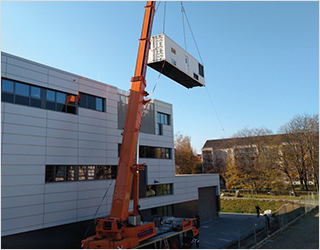Test plant TABEA: EB Technology for Cleaning of Exhaust Gases and Wastewaters as well as PtX Plasma Synthesis

As a strategic investment of Fraunhofer FEP, the mobile test plant TABEA was realized with the company CREAVAC for the cleaning of exhaust gases and wastewaters as well as for plasma-chemical PtX synthesis processes based on various electron beam technologies.
Effective climate protection is a major challenge of our time and, in the medium term, requires a general shift away from the exploitation and use of fossil carbon deposits, not only as energy sources but also as raw materials for the chemical industry. When transforming the energy supply to regenerative sources, highly efficient storage technologies are required on a large scale, in particular to compensate for seasonal fluctuations. Chemical energy storage systems are indispensable for this purpose. A defossilized raw material supply requires the development of a carbon cycle economy, in which the material use of CO2 as an educt of chemical syntheses will play a major role. In this context, Fraunhofer FEP has set itself the goal to evaluate the conversion of carbon dioxide, e. g. with (future green) hydrogen, in atmospheric electron beam plasmas and to proof the advantageous energy efficiency and conversion degree of this novel, industrially scalable PtX process. (PtX = Power-to-X stands for production of chemical energy storage and product raw materials using electrical energy from renewable sources.)
The conceptual approach is based on the fact that the excitation required to overcome the energetic or kinetic inhibition of exothermic reactions, as well as the energy supply for endothermic reactions, is not only possible thermally, but in plasmas also by directly and selectively influencing the binding states of molecules. The key to superior energy efficiency is that the plasmas are thermodynamically in non-equilibrium, which allows the global temperature in the plasma to be kept low despite effective excitation of the chemically active species. Atmospheric electron beam plasmas are also characterized by their uniform energy density and volume filling, which simultaneously promises high conversion degrees.
Electron beam (EB) technologies can also make valuable contri-butions to environmental technologies, such as the cleaning of exhaust gases and wastewaters. Here, fast electrons interact with the constituents of the gases or liquid mixtures and form various excited species as well as ions and highly reactive radicals, which ultimately lead to the chemical degradation of the pollutants. The energy transfer takes place primarily into electronic bonding states, not into heat. This is associated with low energy losses and, like the reactions initiated in this way, is an extremely fast process. A very short residence time is therefore sufficient in the reactor, which can thus be designed to be compact despite the high flow velocity of the treated fluids.
As a platform for all these technological EB applications and financed by a strategic investment of Fraunhofer FEP, the container-integrated, modularly equipped test plant TABEA was developed and built jointly with the company CREAVAC GmbH. The container is mobile, so that even highly explosive gases can be processed at external locations or pilot tests can be offered to industrial users and carried out directly on site.
 Fraunhofer Institute for Electron Beam
Fraunhofer Institute for Electron Beam